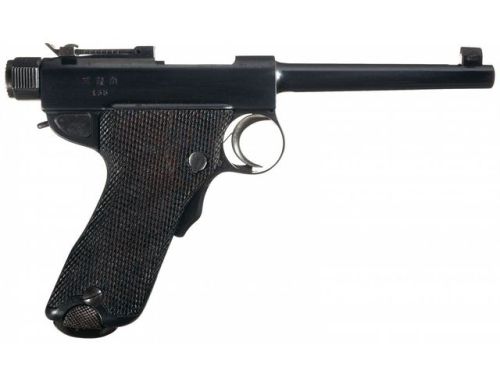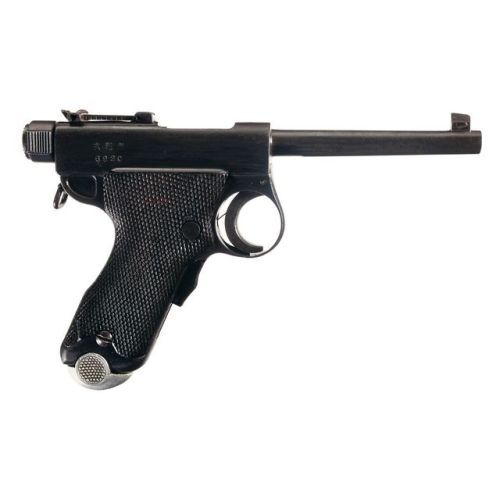peashooter85:The Japanese Nambu Part I —- The Type A “Grandpa” and “Papa” NambuIn 1893 Japan adopted
peashooter85:The Japanese Nambu Part I —- The Type A “Grandpa” and “Papa” NambuIn 1893 Japan adopted its first domestically designed and produced sidearm, the Type 26 revolver. While it was a simple and reliable revolver, times and technology were changing, and soon semi automatics would become a popular option as a military sidearm. Sometime around the turn of the century an arms designer working for Tokyo Arsenal named Kijiro Nambu was ordered to design and develop a modern semi automatic pistol for Japan. The son of a Samurai, Kijiro Nambu was Japan’s most prolific firearms designer, a contemporary of gun designers such as Paul Mauser and John Browning. Unlike Mauser and Browning, however, some of Nambu’s designs were very problematic, overcomplicated, and just plain weird. While Nambu created many good designs, his bad designs give him a bad reputation among military and arms historians.Perhaps Nambu’s most successful designs were his semi automatic pistols, which would become the standard sidearm of the Japanese military from the 1920′s up until the end of World War II.Nambu completed his pistol design in 1902. What he created was a semi automatic pistol that outwardly looked similar to the German Luger, but internally was similar to the German Mauser C96 Broomhandle pistol. Utilizing a recoil operated locked breech mechanism, meaning the inertia generated from the recoil drove the breechblock backwards, while the locking mechanism slowed the momentum of the breechblock so it didn’t create excessive recoil or damage the mechanism. A spring would then drive the mechanism back into place. During the process, the empty cartridge casing would be ejected, and a new cartridge stripped from its 8 round magazine.The Nambu pistol fired an 8x22mm cartridge, also designed by Nambu, which has similar ballistics and stopping power of the .380 ACP cartridge. The pistol featured a grip safety, meaning that the pistol would not fire unless the handle was gripped by the hand.The magazine release was located on the left hand side of the pistol. The magazine did not freely drop from the pistol, but had to be extracted by hand. The pistol featured a rear tangent sight which can be adjusted from 100 to 500 meters. Call it wishful thinking, but I doubt many Japanese officers were making 500 meter shots with their Nambus.The new pistol was called the Nambu Pistol Type A. Two variants were produced, the “Grandpa” Nambu which was the first production model, and the “Papa” Nambu which was an improved model. The Grandpa Nambu began production in 1906 by the Tokyo Arsenal and Tokyo Gas and Electric company. Only 2,400 were produced before production ceased and the modified Papa Nambu was introduced. One major complaint with the Grandpa Nambu was that the trigger guard was too small. Thus the trigger guard of the Papa Nambu was enlarged slightly. The Grandpa Nambu featured a wooden grip on the bottom of the magazine, while the Papa Nambu featured an aluminum grip. Finally the Grandpa Nambu featured a welded lanyard ring, while on the Papa Nambu the lanyard was a separate piece . 7,100 Papa Nambu pistols were produced until production of the Type A ceased entirely in 1923.The Nambu Type A pistol was a fairly well designed pistol for the early 20th century. Perhaps it’s best trait is that it is a very well balanced and accurate pistol. However it did have some problems. First the 8mm Nambu cartridge was quite anemic compared to competitors such as the 9mm Luger, .45 ACP, 7.62x25mm Tokarev, and 7.63x25mm Mauser. However it must be noted that at the time there were many military pistols common in Europe which used small caliber, low pressure cartridges such as .32 ACP. Second, it had very weak firing pin springs which wore out quickly, causing malfunctions and failure to fire. Finally the Nambu had a reputation for being vulnerable to mud, moisture, dust, sand, and extreme temperatures. Considering the Japanese Imperial Army would operated in places such as the frigid Mongolian steppes, hot and humid jungles, or sandy pacific islands, this flaw could be quite problematic. However this reputation is unfair since this is an issue common to all semi automatic pistols, even today. Most of the reliability problems were not necessarily the blame of the pistol or Kijiro Nambu, but from inadequate cleaning and maintenance on the part of Japanese officers who carried them.The Japanese Army chose not to adopt the pistol, not because of design flaws or poor performance, the pistol actually performed well in military testing trials. It’s biggest downside was it was very expensive. Until the end of World War II, Japanese officers were required to purchase their own sidearms. Most chose not to purchase the Type A because there were many foreign imports from Europe which were cheaper but just as good or better than the Nambu in terms of performance. In addition, pistols were not really important to the Japanese Army, with many officers prizing a their swords over their firearms. The only military contract for the pistol was a limited production run for the Japanese Navy and military contracts from Thailand. Among those produced for Thailand was a rare model that featured a detachable buttstock which doubled as a holster.Regardless of it’s lack of popularity, the Type A Nambu saw some limited service with the Japanese Army during World War I. -- source link

